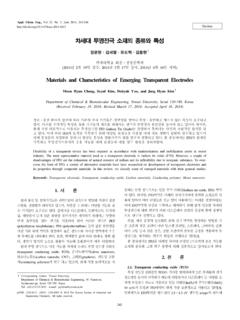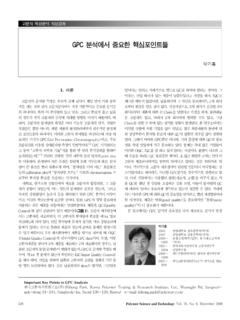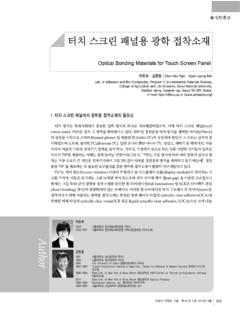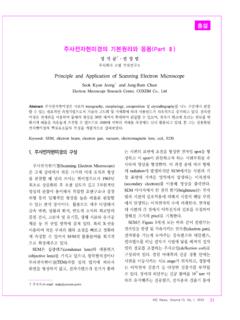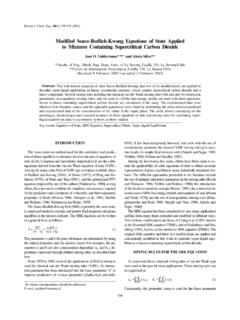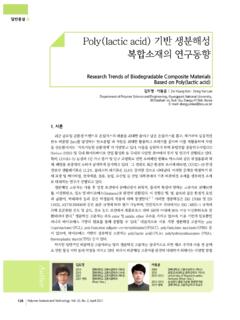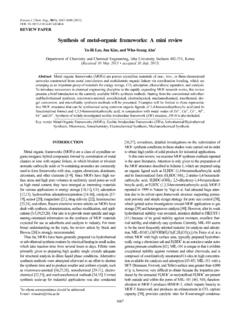Transcription of P 129 Chapter 6. Transition Temperature
1 P 129 Chapter 6. Transition Temperature 1) glass-rubber Transition Temperature (Tg) 2) crystalline melting Temperature (Tm) - can be correlated with the chemical structure by means of a method based on group contributions. 3) there may be three transitions below Tg Tg ~ Tg , Tg ~ Tg , and very low temp (4 ~ 40 K). 4) Between Tg and Tm - rubbery amorphous state and in the crystalline state. 5) liquid state Transition liquid crystals A : The Glass Transition Temperature An additive molar function for the calculation of Tg . (empirical approach ) - the product Tg M behaves as an additive function ; the Molar Glass Transition Function (Yg) Tg (glass Transition temp ) the onset of segmental motion of the polymer backbone.
2 The noncrystalline portion of the material exhibits a Tg . Tm (melting point ) temp. where the largest and most perfect crystallites would melt. Tg sets an upper temp limit for the use of amorphous thermoplastics like poly(methyl methacrylate) (PMMA) or polystyrene (PS) and a lower temp. linit for rubbery behavior of an elastomer like SBR or PBD. 4) Effect of Polymer Structure on Tg a) Flexibility of the macromolecules and the intensitives of intermolecular forces, Ex> Polyethylene(PE), Tg = -120 C Polycarbonate(PC), Tg 150 C Poly( -methyl styrene) Polystyrene(PS) Poly(methacrylate)(PMMA) Tg 168 C Tg = 100 C Tg 105 C - Strong intermolecular attractive forces pull the chain together and hinder relative motions of segments of different macromolecules.
3 Also polar polymers and those have a in which hydrogen bonding are important therefore have a high Tg. Ex> > > > Polyacrylonitrile Poly(vinyl alcohol) Polypropylene PAN, Tg 97 C PVA, Tg = 85 C PVAc, Tg 32 C (PP), Tg -15 C b) Chain Length : Tg is increased with number-average molecular weight. Tg = Tg - u/Mn Tg = Tg of an infinitely long polymer chain U = constant that depends on the polymer CH2 CCH3nCH2CH2nOCOC||OCH3CH3nCH2 CHnCH2 CCH3C=OOCH3nCH2 CHCNnCH2 CHnOHCH2CC=OOCH3 HnCH2 CHCH3nex> polystyrene (Mn=10000, Tg=88 C ) Polystyrene (Mn>50000, Tg=100 C ) c) crosslinking increases the Tg of a polymer.
4 Large shifts of Tg with increased cross-linking are observed, (ex) epoxy or phenolic thermosetting resin. d) The free volume of the polymer Vf. - free volume is the volume of the polymer mass not actually occupied by the molecules themselves: that is, Vf = V - VS where V is the specific volume and VS is the volume of solidly packed molecules. The higher the Vf, the more room the molecules will have in which to move around and the lower the Tg. ex> Tg is increased at high pressures, why ? 5) Tg of Copolymers and miscible mixture. Tg = W1Tg1 + W2Tg2 (Wood equation ) Where Tg is the observed Tg of the copolymer, W1 is the weight fraction of homopolymer1 having Tg1, and W2 is the weight fraction of homopolymer2 having Tg2.
5 (Ref.) , , 28, 319(1958). (Fox equation) (Ref: , ,1(2),123(1956)) ( Couchman eq.) (Ref: , Macromolecules,11, 1156(1978) Kim and Burns, ,34,945(1987) ) 22111gggTWTWT+=2211222111lnlnlnppgpgpgCW CWTCWTCWT + + =Where Cp = CpL(Tg) - Cps(Tg) = difference in molar heat capacity at Tg, where CpL(Tg) is the molar heat capacity at Tg, and Cps(Tg) is the molar heat capacity of the solid at Tg Ex> polycarbonate and poly(e-caprolactone) are known to be miscible. What is the Tg of the mixture if Wpc= ? Tgpc=150 C , TgpcL=-40 C (sol) using Fox eq. 6) Measurement of Tg (cc/g) Tg 8 16 24 32 40 ( C) Tg : second order Transition vs T : condinuous d /dT vs T : discontinuous P 132 Yg = igiY= Tg M Tg = Yg / M = igiY/ M ))40(273( )150273( +++=gT1.
6 Theunbranched polymethylene chain Ex) amorphous polymethylene Tg 195 10K. Yg(-CH2-) = 195 = 2736 140 (K g/mol) = (K kg/mol) (see Table ) for Tata Comparison between calculated and experimental values. (see Table ) (Ex ) Estimate the limiting value of Tg for polylactams(aliphatic polyamides) at increasing number of CH2 groups in the chain. (sol) ( (CH2)n-CONH ) n From Table Yg = n Yg(-CH2-) + Yg(-CONH-) = +15 M = Nm(CH2) + M(-CONH-) = 14n + 43 For Nylon-6 Tg = 4314150004300++nn =MYg n 5 = 11336500 = 323K = 50 C (for Nylon-6) p 142 (Ex ) Estimate the Tg of poly(hexadecyl methacrylate) CH2 CCH3C=OO(CH2)15CH3nFrom Table (p 139) and ( ). ( p 137) N >9 Yg Yg9 + (N-9) Yg9 = Yg = Yg9 + (N-9) = + (15-9) = (K Kg/mol) M = M0( ) + 15 x = 311 (Tg exp = 288K) (see Table , p 144) P 145 (EX ) Estimate the Tg of PEEK (sol) the molar mass = Yg ( ) = (Table ) ( +4+4)= Yg ( ) = 84 (Table ) Yg = 121 = (exp.
7 Tg=414~433) *DSC, == OOC||OnOOC||OP 146 (Ex ) Estimate the Tg of the polyimide, Ultem 1000 ( ). (sol) Tg=K4935781000285= Tg(exp) = K490 P 146 Other factors influencing the value of Tg. 1. Pressure dependence of Tg. +=gggSTT)0()( 2. The influence of molecular weight nggMATT =)( 3. The influence of tacticity. 112)()(isotacticTgicsyndiotactTg 4. The influence of cross-linking. Cross-linking increases the Tg of a polymer. B. The Crystalline Melting Point An additive molar function for the calculation of Tm - Molar Melt Transition Function )/(molkgKMTYY miinm == , MYMYT mimm == ( ) NCC||||OOOCCH3CH3 OCCN||||OOn PEEK DSC Themogram ( ) Derivation of the group contributions of Ym.
8 1. The unbranched polymethylene chain - the melting point of pure polymethylene is 409K.(136 C) Yn( - CH2 - ) = 409 = 5738 (K kg/mol) 2. Aliphatic carbon chains with small side groups. (see Table ) 3. Aliphatic carbon(main-) chains with long side chains ( Comb polymers) (T : trivalent) (E : monovalent and group) P 156 N=5 Ym = Y5 ( ) N<5 ( ) P 161 N>5 ( ) P 163 Comparison between calculated and experimental values. ( ) Estimate the crystalline melting points of poly(vinyl 1-decyl ether), the structural formula Is (sol) For n>5 Yn=Ym5 + (N 5) ( ) (P.)
9 152) From Table ( ) gives for poly(ethers), Ym5 = (K Kg/mol) M0 = (g/mol) )59( += nY M = + 9 = 184 CH2T(CH2)nEnCHCH2O(CH2)9CH3n KmolgmolgKTm288)/(184)/( = Tm(exp) = 280(K) good agreement the structual formula is (sol.) For N>5 Ym = Ym5+ (N-5) ( ) from Table ( ) gives for poly(ethers); Ym5= and Mo = Ym = + (4)= , M= + 9 = Tm(exp) = 280K (fair agreement) (EX ) Estimate the crystalline melting point of UDEL polysulfone, From Table ( ) Ymi Ygi Mi 133 111 From Table (P153) 2 -O- 27 87 Tm : structure flexibility : poly(ethylene oxide) poly(p-xylene) Tm=66oC Tm=375 oC strong intermolecular forces : ex) polyamide-strong hydrogen bonding has higher Tm than polyethylene.
10 N-6 PE ex) Nylon-6 has higher Tm than N-11. Tm=225 oC Tm=194 oC Crystallinity : a periodic, regular placement of the atoms of the chain isotatic. bulky side group crystallization rate . (by preventing the close approach of different chain segments). crystallization occurs between Tm and Tg. Because of the effects of increasing concentrations of stable nuclei. Crystallization rates are zero at Tm and Tg. Because the cooler conditions reduce the rate of conformational changes By DSC (Differential Scanning Calorimetry) Typical DSC thermogram of partially crystalline polymer Determination of Tg by midpoint-method (Ref. Shultz and Young, J.
